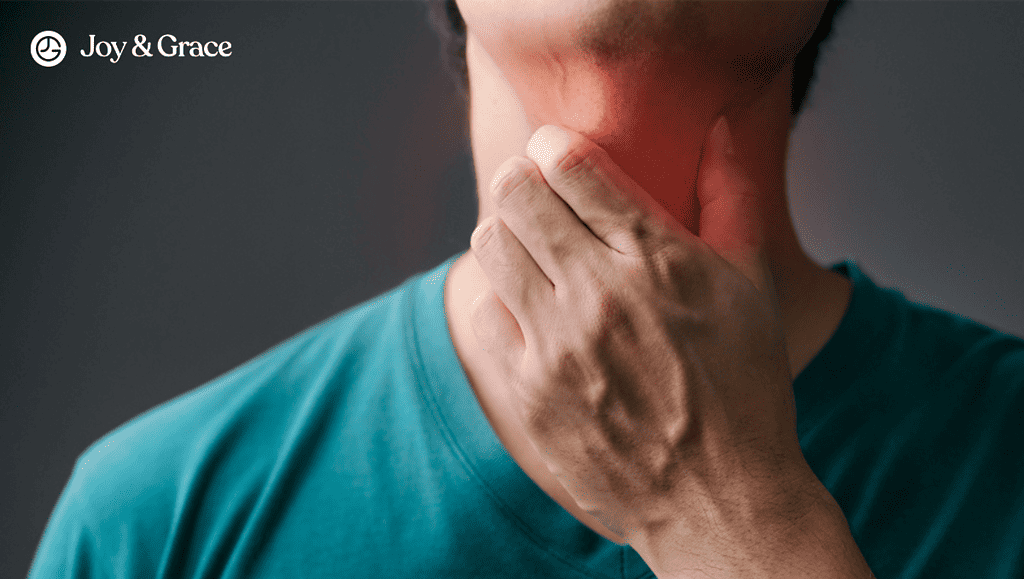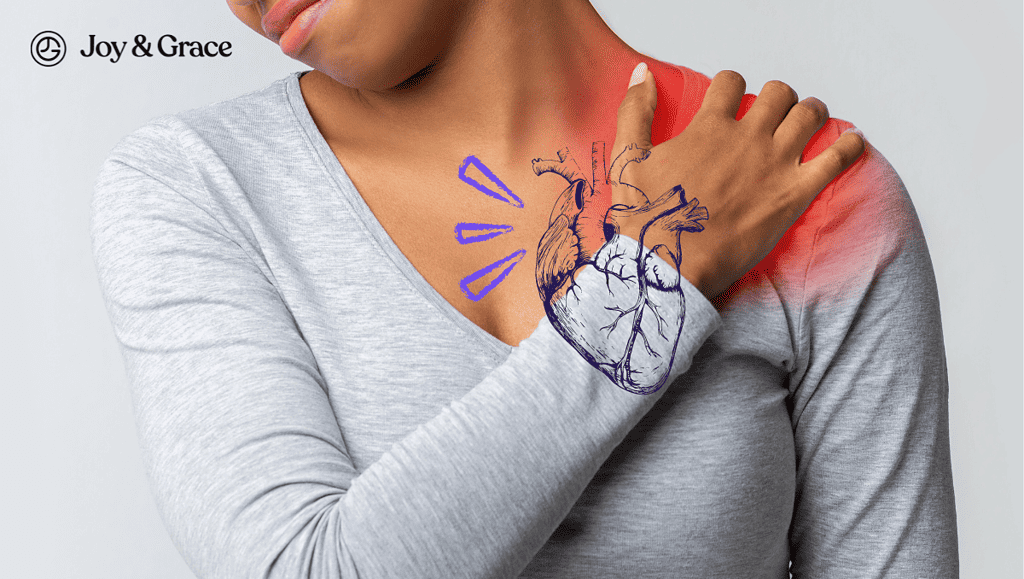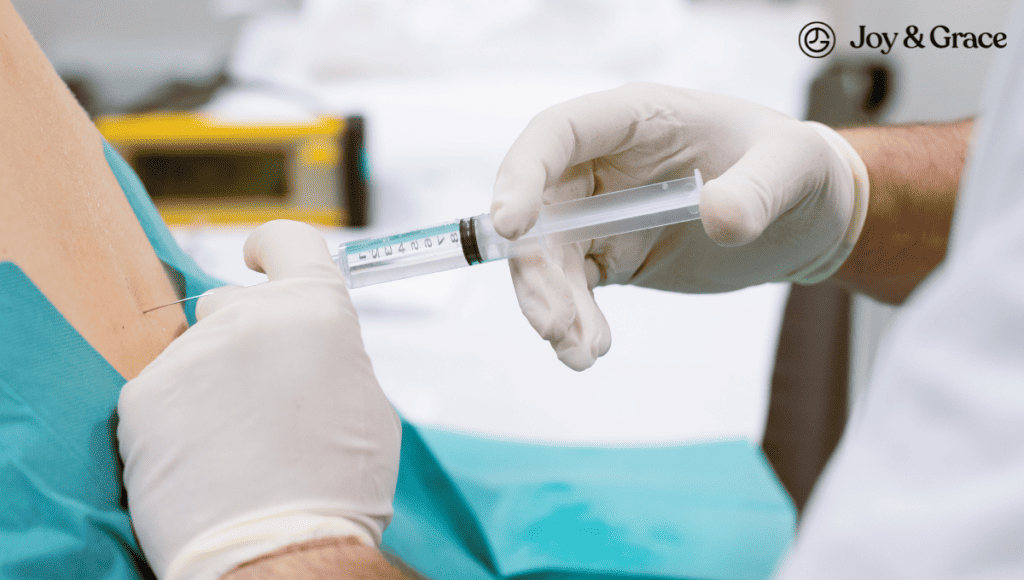Pain in the tricep and shoulder. You might be familiar with it. It is a common issue that stems from various causes and affects many people. Whether you are an athlete, a desk worker, or a busy parent, pain in the tricep and shoulder is not discriminatory.
Understanding the root of it and finding the right management strategies can relieve your pain and improve your life quality. Let us discover how you can take a step towards freedom from the debilitating discomfort.
Can Tricep Pain Cause Shoulder Pain?
We will save the suspense by giving you a straightforward answer right away. Yes, triceps pain may cause shoulder pain. But the opposite also holds true: shoulder problems may lead to triceps pain as well.
To understand how the tricep is connected to the shoulder, we first need to go a little bit into anatomy. Let us begin and stretch out this topic (upper) arm in (upper) arm!
Understanding the Anatomy and Function of the Shoulder and Tricep
The triceps is a bilateral muscle located in the back of both upper arm bones. It is called “triceps” because it has three heads or three tendon insertion points: the medial, lateral, and long head. The first two of these are located in the upper arm. The long head climbs all the way up to the shoulder joint capsule and shoulder blade.
The main function of the tricep is to extend the arm at the elbow joint. It gets activated, for example, when reaching for your favorite mug on the top of the shelf.
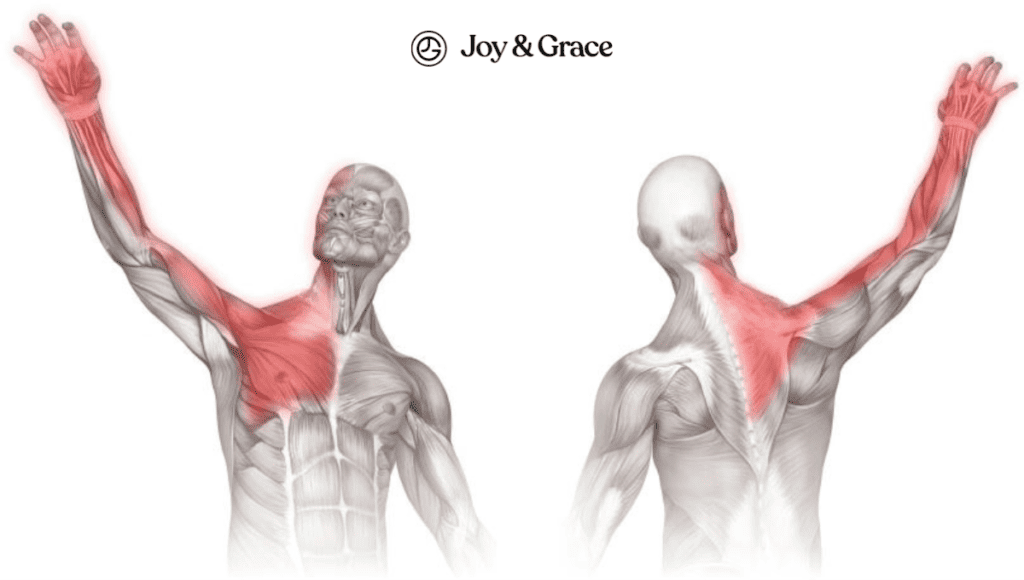
The shoulder, on the other hand, contains a major joint called the glenohumeral joint. This joint allows us to move our arms in different ways and directions. Because of the long tendon that climbs up, the tricep also affects the function of the shoulder joint. As we can see, the tricep and shoulder are connected.
Now that we know about the anatomy of the implicated structures, let us discuss the causes of tricep and shoulder pain.
What Causes Pain in Both Triceps?
If one or both of your shoulders and triceps hurt, you may wonder about the underlying cause of the pain. Is it possible that something you did or experienced resulted in the pain? Some of the scenarios below might ring a bell.
Here are some of the most common causes of pain in the tricep and shoulder:
- Overuse injury. This can occur if you repeatedly perform certain movements, such as throwing a ball or lifting heavy items. These movements may put intense pressure on your tricep muscles and shoulder parts. As a consequence, pain may appear.
- Traumatic injury. Trauma or injury, such as a fall or direct blow, can lead to shoulder and tricep pain. Trauma may lead to a rotator cuff injury (such as a tear) or a dislocated shoulder—two very painful conditions.
- Tendinitis or Arthritis. These are must-remember inflammatory conditions, which can cause shoulder and tricep pain. In these conditions, the protective tissue around the joint becomes inflamed. Tissue inflammation goes hand-in-hand with lots of pain and discomfort.
Triceps tendinitis, as the perfect example, is associated with inflammation of the tendon of the triceps muscle. - Radiculopathy. This condition happens when there's compression of a nerve in your neck or upper spine. No, it does not mean someone (necessarily) pinched it. It means that the route of a nerve is getting blocked, for example, from a disc herniation. Radiculopathy can lead to pain that spreads down your arm, affecting your shoulders and triceps. Symptoms of radiculopathy may include the following additional symptoms:
- Neck pain,
- Numbness,
- Weakness, and
- Tingling.
Can Stress Cause Tricep Pain?
Absolutely, stress can lead to tricep and shoulder pain! How does this happen? When you are under physical or emotional stress, your body tends to tense up. Your muscles, including the triceps, become tight. With prolonged and constant tension, your muscles strain, and you may develop pain. Stress may also cause musculoskeletal pain by affecting work and sleep.
The pain in your triceps can go with or spread to other surrounding areas. These areas include the shoulder and neck.
Chronic stress has many negative effects on health. A nagging, discomforting pain is one of them.
At Joy&Grace, we put a lot of importance on maintaining a healthy body and mind. Managing stress levels is a key component of achieving this goal. Thus, to create the best stress-managing plan for you, we advise you to see your doctor or therapist…and continue reading below!
What Shoulder Injury Causes Tricep Pain?
As mentioned earlier, injuries are one of the causes of tricep and shoulder pain. As you can imagine, you can injure your shoulder in many ways. It can happen while playing sports, during work, or after an unfortunate accident.
Let us dig deeper into the three most common tricep conditions resulting from shoulder injuries.
Rotator Cuff Tendinitis
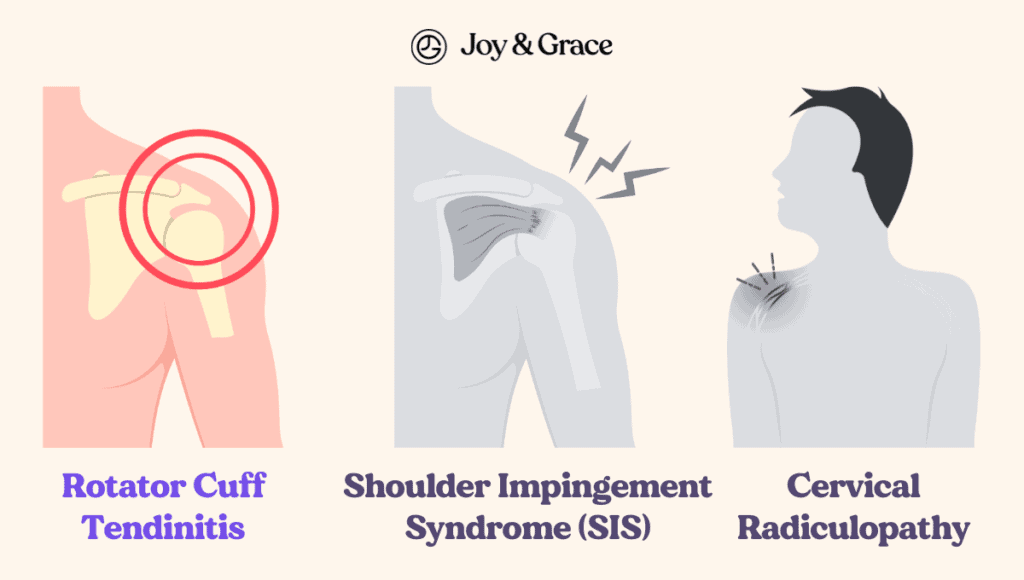
The rotator cuff includes a group of muscles located around the shoulder joint. They aid in providing various shoulder and arm movements.
Sometimes, though, these muscles may become inflamed or damaged from injury. This can cause pain, which may radiate down the arm. The damage or inflammation may affect the tricep, causing triceps tendinitis. In severe cases, the pain extends to the elbow.
Shoulder Impingement Syndrome (SIS)
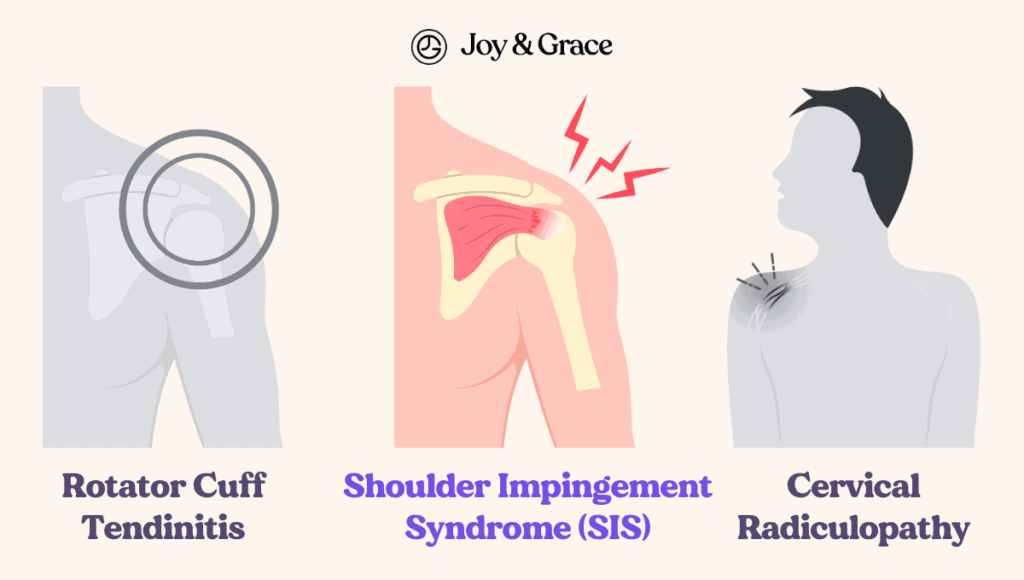
Shoulder Impingement Syndrome is also known as “swimmer’s shoulder.” It occurs when the subacromial space narrows, resulting in pain when lifting your arm. The pain can extend from your shoulder to your tricep, making it even more challenging to do simple tasks.
Cervical Radiculopathy
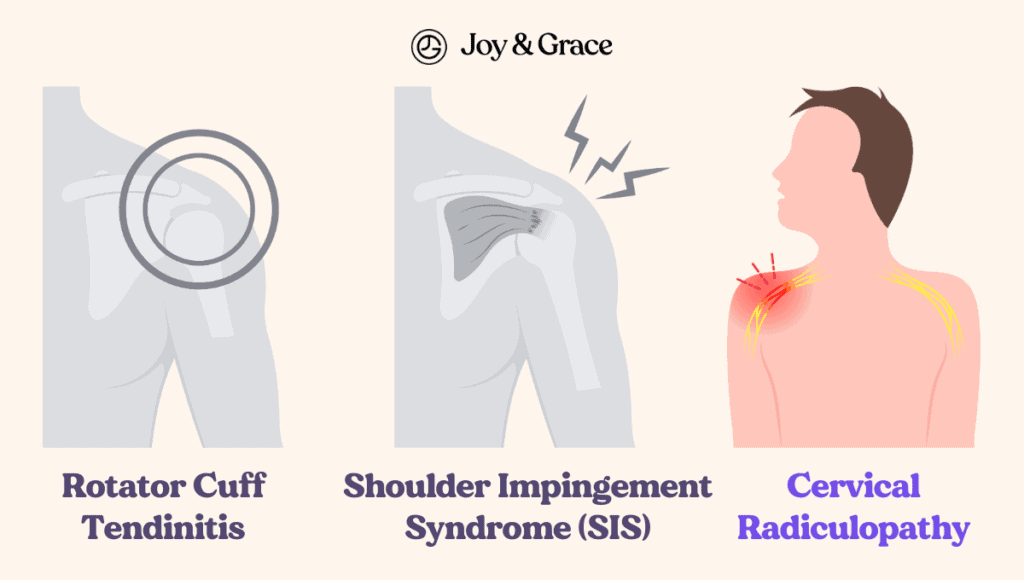
As we mentioned, pressure on a nerve that comes out of the spine may also cause shoulder and triceps pain. The sources of tricep pain are often radiculopathies of the C6, C7, and C8 nerve roots. Radiculopathy most often arises from neck injury or arthritis types (such as rheumatoid arthritis).
What Diseases Cause Upper Arm Pain?
By now, we know that several medical conditions and diseases can cause upper arm and shoulder pain. We have mentioned overuse injuries, traumatic injuries, strains, and nerve disorders as some of the most common causes. We have also mentioned inflammatory diseases, such as rotator cuff tendinitis and triceps tendinitis, as potential causes.
Another condition that may cause shoulder and tricep pain is adhesive capsulitis. This condition is also known as “frozen shoulder.” Adhesive capsulitis represents inflammation of the shoulder joint capsule. It restricts movement in the shoulder and often leads to dull or aching pain.
What about the more unusual scenarios? An interesting cause of tricep and shoulder pain is heart disease. Heart disease can rarely result in referred pain in the upper left arm due to an impending heart attack. You should know that tricep and shoulder pain is just one of the many signs of heart disease, though. Other typical signs include chest pain or discomfort, breathlessness, jaw and neck pain, sweating, nausea, dizziness, and an irregular heartbeat.
Thus, it would be wise to inform your doctor, especially if you are dealing with severe tricep and shoulder pain. This might be a sign of a more serious injury or inflammation process going on.
Is Tricep Tendinitis Serious?
Tricep tendinitis is an inflammatory condition that affects the tricep tendon. The triceps tendon is a fibrous band that attaches the muscle to the bone. It can be serious if not properly treated. If untreated, tricep tendinitis can lead to chronic pain and further injuries, such as torn tendons.
What Are the Symptoms of Tricep Tendinitis?
Common symptoms of triceps tendinitis typically include the following:
- Tricep pain
- Pain in your shoulder and elbow
- Tenderness and warmth in the triceps area
- Loss of strength and flexibility in your arm.
Identifying the Symptoms Related to Pain in the Tricep and Shoulder
Pain in the tricep and shoulder may vary a lot from person to person. It may come along with associated symptoms, such as:
- Swelling or tenderness to palpation,
- Loss of strength,
- Limited extension at the elbow,
- Ecchymosis (small discoloration of the skin), edema, or a hematoma (larger discoloration of the skin) in the upper arm.
Where is Tricep Pain Located?
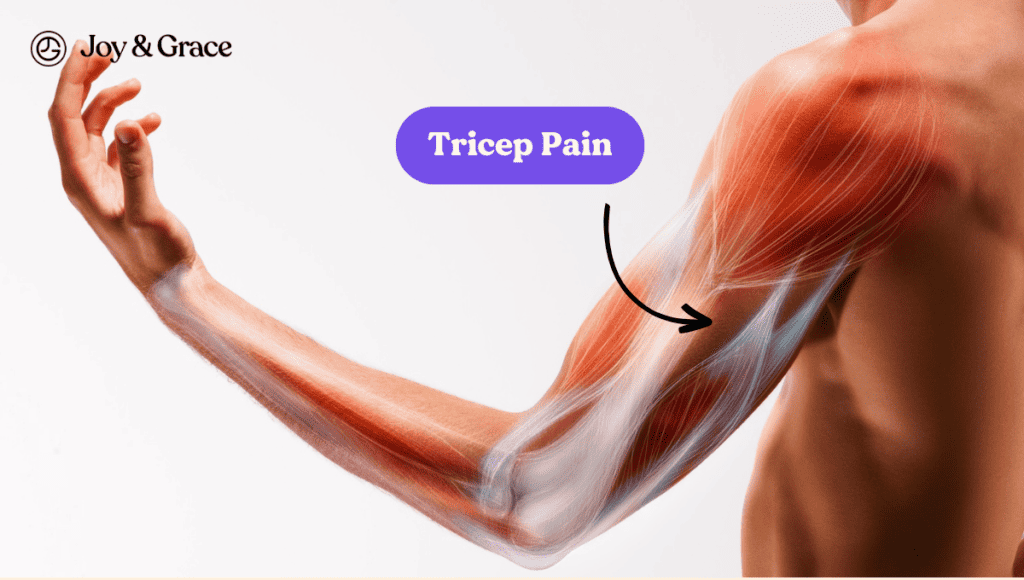
Let us talk more about the specifics of tricep pain. Tricep pain is primarily located in the back part of the upper arm. That is where the muscle itself is located. Tricep pain from a condition such as tricep tendinitis can also be felt in neighboring parts. Why so? Muscles and the nerves that supply them are interconnected. This usually means it can spread or radiate to the shoulder, elbow, or neck.
Keep in mind, though, that the location, radiation, and severity of tricep pain depend on the root cause.
How Long Does Tricep Pain Last?
So, you are dealing with tricep pain. One of your main concerns is getting rid of it fast. Can the pain heal on its own? How long does recovery take? Well, the duration of tricep pain may vary (1, 2). It depends upon the underlying cause and the treatment you receive. Thus, we encourage you to consult your doctor.
Mild strains or injuries could heal within a few days to weeks. Adequate recovery can be achieved with home remedies. Read below to find out the best treatment methods you can use at your own home.
More significant injuries, like tricep tendon tears, might take several weeks to a few months to fully recover.
Conditions like tricep tendinitis or bursitis might have varying recovery times. Acute bouts could resolve in a few weeks, but chronic cases may persist for several months. Rotator cuff disorders or shoulder impingement can also cause tricep and shoulder pain that lasts for weeks to months.
Always follow the treatment plan that your healthcare provider devises. This is the best way to recover quickly and prevent a recurrence.
What Does a Torn Tricep Tendon Feel Like?
A torn tricep tendon represents the detachment of the triceps tendon from the bone. This condition usually manifests as a sharp or intense pain in the shoulder, tricep, and elbow. The pain usually worsens when moving your arm, particularly when trying to extend it.
What Does a Tricep Strain Feel Like?
We already mentioned injuries to the triceps tendon. But the triceps muscle fibers may be affected too.
A tricep strain is an injury to the muscle fibers of the tricep. This injury happens when the fibers are stretched too much, almost to the point of tearing. A strain is characterized by intense and sharp pain after a sudden impact or force. It may arise during intense physical activities like sports or lifting weights. The affected area between your shoulder and tricep will often feel tender. It may even be swollen or bruised. You may also experience a loss of strength.
The pain may become worse if you elevate your arm above your head.
What Nerve Causes Pain in the Tricep Area?
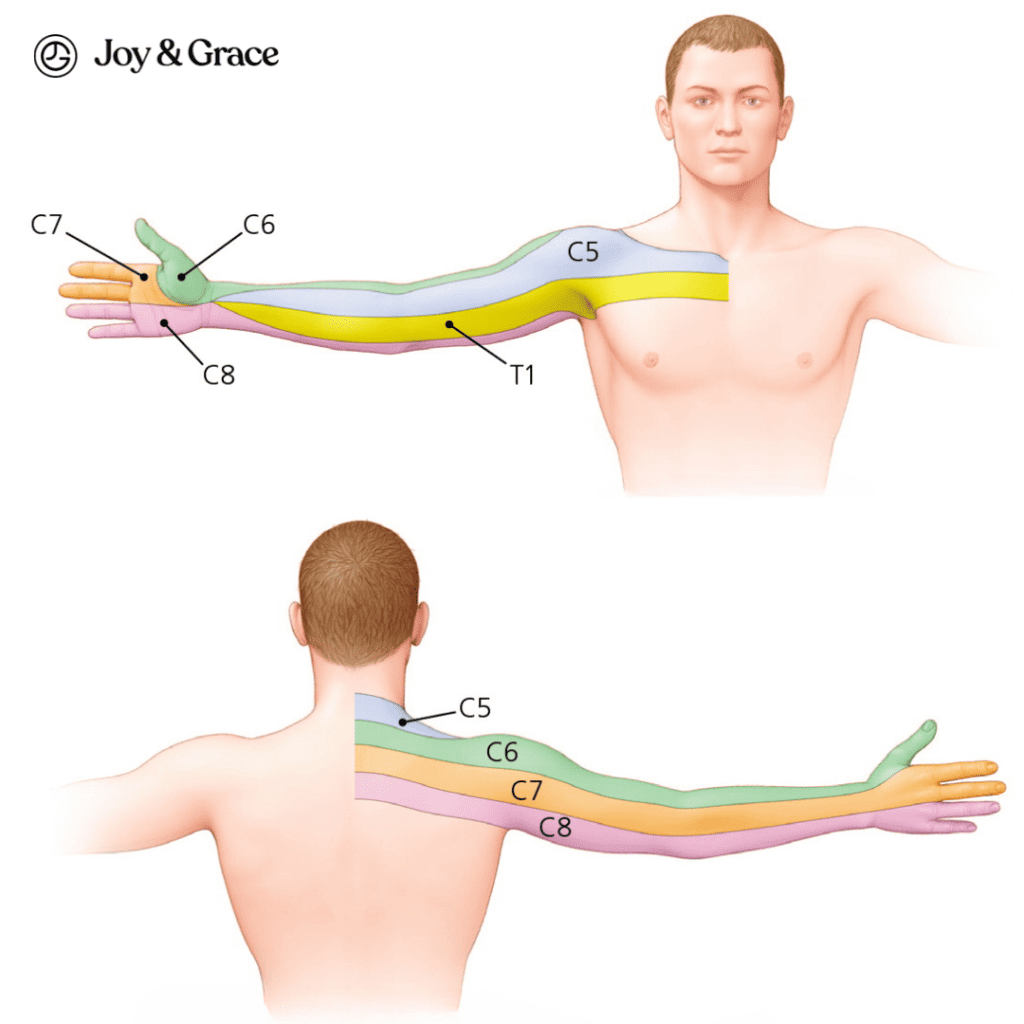
The nerve responsible for the innervation of the triceps is the radial nerve. This nerve branches from the brachial plexus of nerves. It contains fibers from the C6, C7, and C8 nerve roots. Damage to the spine, radiculopathies, various injuries, and other disorders that damage the radial nerve may affect the function of the triceps muscle.
When Should I See a Doctor for Tricep and Shoulder Pain?

If you have already reached this point in the article, you might be a little worried and confused. We do not blame you. But we are here to tell you that there is certainly hope. Thankfully, there are doctors who can provide you with advice and treatment for tricep and shoulder pain relief. So, when would be the right time to seek medical attention for tricep and shoulder pain?
Understandably, every person’s body is different. But there are a few rules of thumb that can guide you. You may want to visit your healthcare provider if you notice any of the following:
- The tricep pain is severe or chronic. Chronic means the pain lasts more than a couple of weeks despite self-care.
- You are unable to move your shoulder or elbow due to the pain.
- Pain comes with symptoms such as fever, weight loss, or persistent fatigue. These might be signs of an ongoing infection.
- Your tricep and shoulder pain limits your daily activities.
- You are unable to sleep because of the discomfort.
- You have had a shoulder or arm injury.
- Home remedies and medicines have not worked against the pain.
Do not neglect your pain. Do not hesitate to consult your healthcare provider if your tricep and shoulder pain worries you.
What Doctor Treats Tricep Pain?
Various medical professionals can treat your tricep and shoulder pain. But who you should you refer to first? Let us see below.
- Primary Care Physicians (PCPs). In most cases, the first doctor you should see for your tricep pain is a Primary Care Physician. A PCP may prescribe painkillers, order imaging tests, tell you how to manage pain at home or refer you to secondary or tertiary care.
- Orthopedic Specialists. Orthopedic specialists are the most well-suited doctors for muscular and skeletal problems. They treat injuries and diseases of the bones, muscles, tendons, and ligaments. Tricep and shoulder pain is certainly no exception.
- Sports Medicine Specialists. These are doctors that deal with pain and symptoms from activity-related injuries. If you suspect an injury after playing some afternoon baseball, a sports medicine doctor may come to the rescue.
- Physical Medicine and Rehabilitation Specialists (PM&R Specialists, Physiatrists). Physiatrists are doctors who help patients recover from conditions that affect the mobility and function of body parts. They use various methods to relieve pain and promote quick recovery.
- Neurologists. If your tricep pain comes with neurological symptoms, you might want to check with a neurologist. Neurologists are doctors that deal with diseases of the nervous system.
Do I Need A Referral To See A Medical Specialist?
Whether you need a referral to see a specialist depends on your insurance plan. Do you have an HMO plan or a PPO? Find out more about medical insurance plans from this link. If your insurance plan says you need a referral from your PCP, make sure to make appointments beforehand.
Diagnosing Shoulder and Tricep Pain: What is the Test for a Tricep Injury?
The diagnosis for tricep and shoulder pain always starts with history taking. Your doctor will ask you about the type, intensity, and duration of your pain. They will want to know if you have had an injury, accident, or previous cases of similar pain.
Your doctor will then perform a physical examination. Useful tests for tricep tendon damage include the following:
- Range of motion (ROM) test,
- Palpation of triceps tendon insertion, and
- A modified Thompson test.
Imaging tests, such as X-ray, MRI, or ultrasound, may be used to visualize the bones, muscles, tendons, and ligaments. They might be helpful when the diagnosis remains unclear after the physical assessment.
Reaching the correct diagnosis is very important. It provides a beneficial roadmap to a successful treatment plan. Understanding your pain and coming up with a diagnosis are the first steps toward relief and eventual healing.
How Do I Get Rid of Shoulder and Tricep Pain?
Tricep and shoulder pain can be annoying and difficult to live with. But the good news is that there are treatments that can ease your upper arm and shoulder pain and make your daily life much better. Read along to find out what they are.
Treatment Options for Shoulder and Tricep Pain

After reaching a diagnosis, your doctor will come up with a treatment plan tailored to your needs. The treatment plan for tricep and shoulder pain may include medical treatments and home remedies. The most effective treatment options for shoulder and tricep pain include the following:
- Pain medications (Tylenol, NSAIDs). These meds fight inflammation and effectively ease pain (which is why they are called “painkillers”).
- Home remedies. You may manage your pain in the comfort of your own home. We have a list of home remedies just below.
- Physical therapy. Physical therapy can range from passive treatments to active exercises. These focus on flexibility, range of motion, and strength building. Passive treatments could include ultrasound, electrical stimulation, or ice massages. Active exercises involve various stretching and strengthening exercises for the affected area.
- Steroid injections. If triceps tendonitis symptoms fail to improve after two weeks of rest, ice, and medication, then your doctor may advise a corticosteroid injection.
- Surgery. Surgical treatment may be recommended for severe cases or when all other treatments have failed.
At-home Care for Shoulder and Tricep Pain

As we said, your doctor might recommend you treat your tricep pain at home. Here are some effective home remedies for shoulder and tricep pain relief:
- Rest and cold therapy. Resting your muscles and joints is key to promoting recovery at first. Ice packs can help decrease inflammation and numb the area to ease the pain. This method is more effective in the first 48 hours following the onset of pain.
- Heat therapy. Warm compresses and heating pads can reduce inflammation and tricep pain. Heat achieves this by improving blood circulation in the affected regions. Heat therapy is not recommended for intense inflammation.
- Mobility exercises: These include pendulum-like exercises or arm stretching. They can help improve shoulder mobility and loosen tight triceps. They also relieve stiffness and increase the range of motion, reducing pain.
- Strength training. Strength training can gradually increase strength in your shoulders and triceps. When these muscles are stronger, they are less likely to cause pain in the future.
- Topical treatments. These include gels containing NSAIDs or products like capsaicin and menthol. They can relieve tricep and shoulder pain when applied to the affected area. They are particularly effective for mild to moderate pain and can be used multiple times daily.
- Massage therapy. Regular, gentle massages can ease muscle tension, promoting relaxation and pain relief.
Always remember to inform your doctor before performing any exercise or using any medication. In this way, you might prevent doing damage instead of helping yourself.
How Do You Relieve Tricep Tendon Pain?
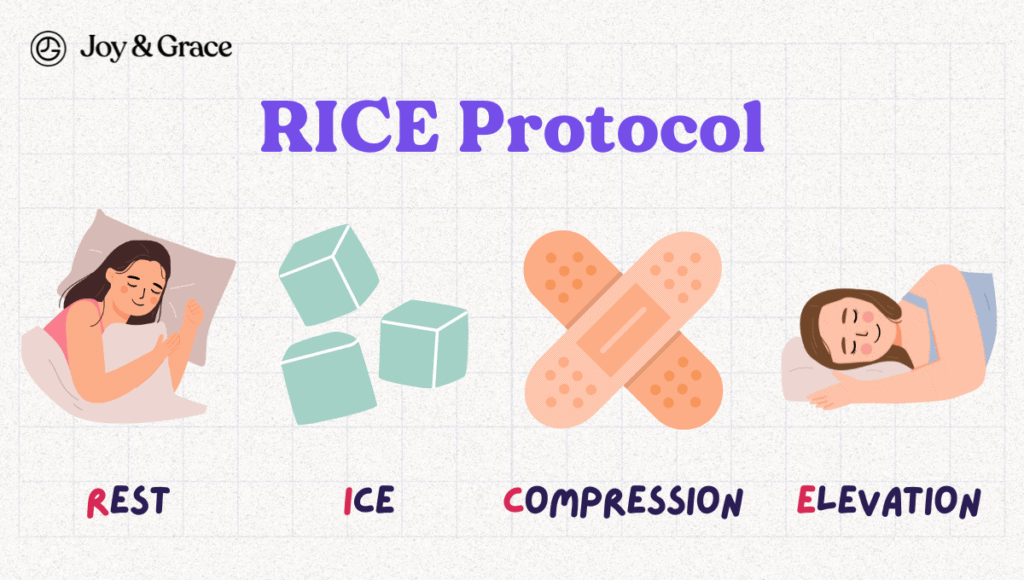
Treatment for tricep tendon pain from injuries usually depends on the severity of the injury and the duration of the pain. Triceps tendinitis is generally managed with conservative treatment methods. These include the following:
- Resting,
- Ice therapy,
- Using braces or slings for support,
- Painkillers such as NSAIDs.
Conservative treatment is a reasonable option for partial triceps tendon tears in 75% of cases. If the pain lasts more than six months with treatment, surgery is recommended. For complete tears, surgery is the preferred treatment method.
Does Tricep Tendinitis Go Away?
With the right treatment and care at home, triceps tendinitis may go away. So, how long does it take for tricep tendinitis to heal? Adequate recovery of the triceps function usually takes 4-5 weeks after injury. If the pain lasts longer, your doctor may re-evaluate the diagnosis and recommend other treatment methods.
Prevention Strategies to Avoid Shoulder and Tricep Pain
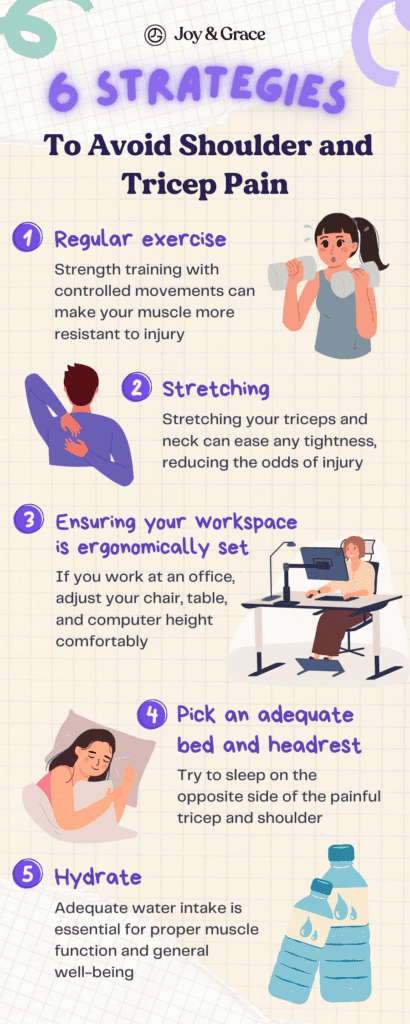
If you have experienced shoulder and tricep pain, you will probably want to put an end to it. What can you do to never deal with this type of pain again?
Preventing shoulder and tricep pain involves making some healthy lifestyle changes. Begin by maintaining good posture. Slouched shoulders can lead to shoulder pain and tricep pain. Keep your shoulders pulled gently back, but do not overdo it! A relaxed and upright posture is the way to go.
- Regular exercise can aid in preventing pain between your shoulder and tricep. Strength training with controlled movements can make your muscle more resistant to injury. Though, it is essential not to overstrain the muscles. Start gradually, and increase intensity over time.
- You will want to combine your exercises with stretching. Stretching your triceps and neck can ease any tightness, reducing the odds of injury. Keep in mind to take it slow – your muscles will thank you for it.
- Ensuring your workspace is ergonomically set also helps reduce shoulder tricep pain. If you work at an office, adjust your chair, table, and computer height comfortably. This contributes to maintaining good posture and reduces triceps and shoulder strains.
- How do you sleep to prevent tricep and shoulder problems? First, you need to pick an adequate bed and headrest to avoid sleep problems. Try to sleep on the opposite side of the painful tricep and shoulder.
- Last but not least, hydrate! Dehydration can lead to shoulder cramps or tight triceps. Adequate water intake is essential for proper muscle function and general well-being.
Takeaway
Tricep pain may cause shoulder pain. Shoulder problems may lead to tricep pain as well.
The triceps is a bilateral muscle located in the back of both upper arms. It is called “triceps” because it has three heads. The primary function of the tricep is to extend the arm at the elbow joint.
The most common causes of pain in the tricep and shoulder are the following:
- Overuse injury
- Traumatic injury
- Radiculopathy
- Inflammatory conditions such as arthritis or tendinitis
Shoulder and tricep pain may also be a symptom of heart disease.
Depending on the cause, tricep and shoulder pain may come along with associated symptoms, such as:
- Swelling or tenderness to palpation,
- Loss of strength,
- Limited extension at the elbow,
- Ecchymosis, edema, or a hematoma in the upper arm.
Do not neglect your tricep and shoulder pain. Do seek medical care if:
- The pain lasts more than a couple of weeks despite self-care.
- You are unable to move your shoulder or elbow due to the pain.
- Pain comes with symptoms such as fever, weight loss, or persistent fatigue
- Your tricep and shoulder pain limits your daily activities.
- You are unable to sleep because of the discomfort.
- You have had a shoulder or arm injury.
- Home remedies and medicines have not worked against the pain.
The best doctors for tricep and shoulder pain include the following:
- Primary Care Physicians
- Orthopedic Specialists
- Sports Medicine Specialists
- Physical Medicine and Rehabilitation Specialists
- Neurologists
The most effective treatment options for shoulder and tricep pain include the following:
- Pain medications
- Physical therapy
- Home remedies
- Surgery
It is recommended to rest and apply ice to the triceps area after an injury.
Preventing shoulder and tricep pain involves making healthy lifestyle changes, such as:
- Maintaining a good posture
- Resting
- Properly exercising
- Maintaining a good sleep position
- Keeping yourself hydrated.







